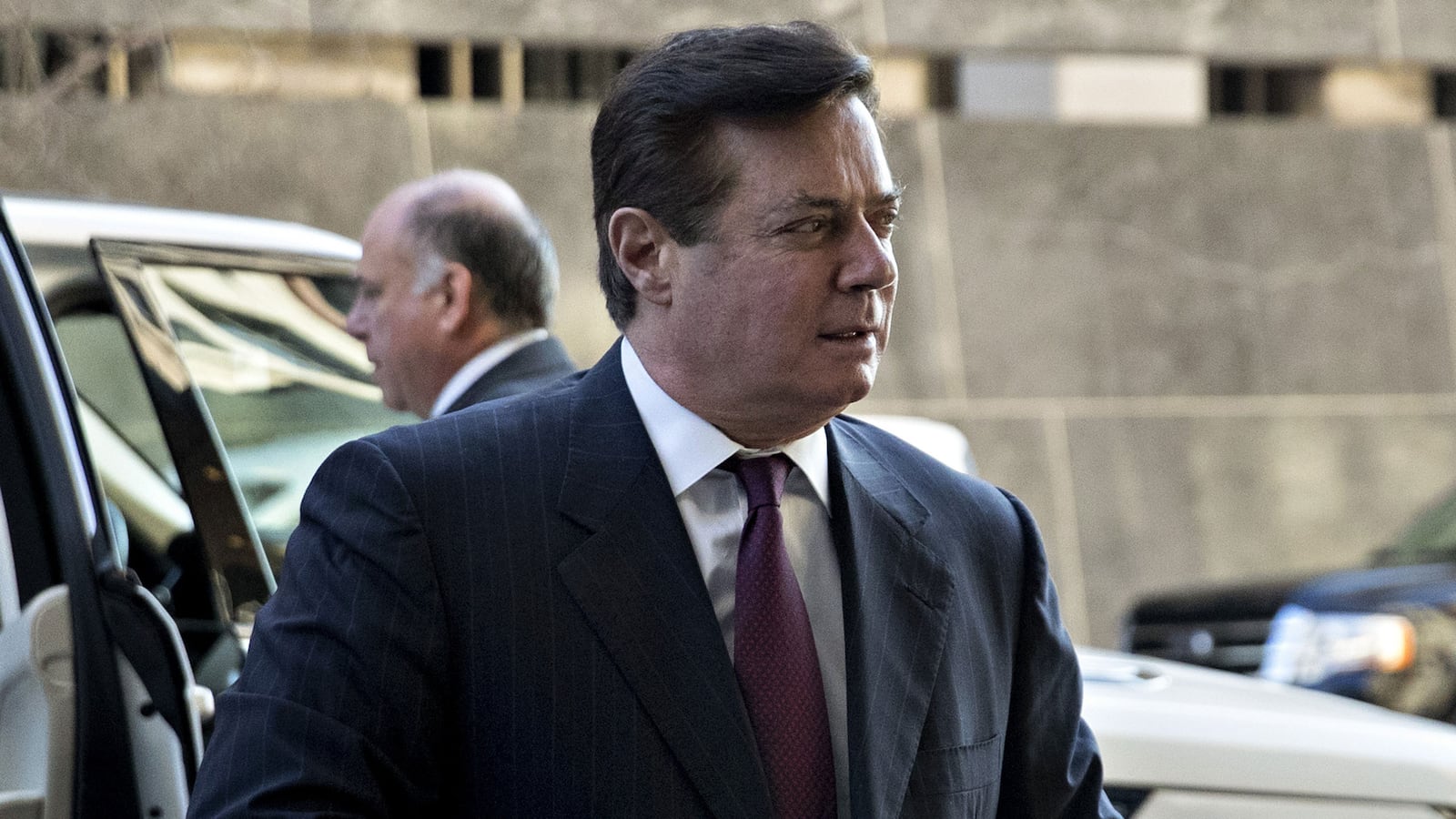Paul Manafort, President Trump’s former campaign chairman, could face up to and 22 years in prison for conspiring against the U.S. and a conspiracy to obstruct justice connected to his covert lobbying on behalf of Ukraine’s former pro-Russian government.
Manafort is already looking at a stiff sentence from a separate case against him in Virginia on tax and bank fraud charges. A pre-sentence investigation report for that conviction estimated that he faces a recommended sentence of between 19 to 24 years in prison.
President Trump has repeatedly praised Manafort and hinted that he would not rule out a pardon for his former campaign manager.
In a sentencing memo filed Saturday, Special Counsel Robert Mueller’s laid out how Manafort “repeatedly and brazenly violated the law” over the course of a decade. Mueller’s office did not take a position with respect to the sentence imposed on Manafort, but instead laid out the standard range of time criminals face for crimes that match those of Manafort’s. The office took a similar position in the Virginia case. Mueller’s team also suggested to the presiding Judge Amy Berman Jackson that Manafort, if released from jail, is at risk of recidivism.
Manafort’s D.C. case is the longest-running case overseen by the special counsel’s office. The much-awaited sentencing memo, laid out for the public viewing on Saturday, is one of the most sweeping and detailed documents to be filed in the Russia investigation, second perhaps to the one filed by the special counsel’s office for Former National Security Advisor Michael Flynn last year.
The Manafort memo details the general nature of Manafort’s lies to Special Counsel Robert Mueller’s team as well as several other offices in the government and outlines the and depth of his crimes.
“His criminal actions were bold, some of which were committed while under a spotlight due to his work as the campaign chairman and, later, while he was on bail from this Court,” the sentencing memo says. “And the crimes he engaged in while on bail were not minor; they went to the heart of the criminal justice system, namely, tampering with witnesses so he would not be held accountable for his crimes.”
Despite the hundreds of pages of exhibits attached the the sentencing memo, the special counsel’s office offers few details about what Mueller discovered in his interviews with Manafort and does not elaborate on other parts of the ongoing Russia investigation.
Mueller’s team also suggested to the presiding Judge Amy Berman Jackson that Manafort, if released from jail, is at risk of recidivism.
Under a plea agreement struck with prosecutors, Manafort agreed to plead guilty to one count of conspiracy against the U.S. and another count of conspiracy to obstruct justice. In exchange for his cooperation, the special counsel’s office agree to drop the outstanding money laundering and lobbying charges against him. However, the judge in the case ruled earlier this month that Manafort lied to the special counsel’s office and as a result Mueller’s team was no longer bound by the terms of the agreement it signed with him.
In the memo released Saturday, Mueller’s team does not provide any information to suggest Manafort’s cooperation would help him during sentencing.
The case against Manafort in Washington centered on the lobbying work he performed on behalf of his political consulting clients in Ukraine. Prosecutors said Manafort and his Russian-Ukrainian business partner, Konstantin Kilimnik, skirted lobbying rules to pressure the U.S. government on behalf of Kiev’s pro-Russian former president, Viktor Yanukovych.
Manafort used a handful of ruses to make Yanukovych’s case to American officials without registering as a foreign agent, paid for with the help of money he parked in offshore accounts. He used a seemingly independent think tank, European Centre for a Modern Ukraine, to act as a “mouthpiece” for Yanukovych’s government and hired two DC firms, Mercury Public Affairs and the Podesta Group, to lobby for it. The arrangement was designed to skirt lobbying rules and allow the two firms to work on behalf of their true client, Yanukovych, without disclosing it.
In another case, Manafort paid a handful of former European officials, dubbed the “Hapsburg Group,” €2 million to wage a covert influence campaign for Yanukovych in Washington.
Manafort didn’t register as the agent of a foreign principal for his work directing the lobbying and neither did Mercury or the Podesta Group. Instead, he submitted phoney paperwork to the firms telling them that their nominal client wasn’t a cutout for the Ukrainian government, a statement the special counsel’s office argues both Mercury and the Podesta Group knew was false.
A third U.S. company, the law firm Skadden Arps, also played a part in Manafort’s lobbying efforts. Manafort commissioned Skadden to write a report whitewashing Yanukovych’s prosecution of his former rival for the presidency. Alex van der Zwaan, an attorney at the firm, pleaded guilty to lying about his interactions with Manafort, Kilimnik, and Gates and his role in sharing the report with a public relations firm. Skadden settled with the Justice Department and agreed to pay $4.6 million for its failure to register as a foreign agent as part of its work in Ukraine.
When the special counsel’s office charged Manafort in February 2018 and raised the Hapsburg Group, he and Kilimnik reached out to two witnesses in the case, identified as Persons D1 and D1 in an attempt to get them change their testimony about the group’s lobbying work in the US. In a series of phone calls and encrypted text messages, FBI agents discovered Kilimnik and Manafort trying to get in touch with the two men and emphasizing that the Hapsburg Group’s lobbying focus was in Europe.
For weeks, the media has anticipated the special counsel’s filing. And Legal analysts predicted the memo would perhaps unveil never before seen details about the Russia investigation. Many of the previous filings related to the Manafort case in D.C. have been heavily redacted. Portions of the sentencing memo filed Saturday are yet again redacted, but some of the exhibits attached to the filing reveal additional details related to Manafort’s lobbying work for Ukraine. The memo also appears to use redactions as a way to keep under wraps the identities of uncharged individuals.
However, Mueller’s team does not in its memo provide additional details about the nature of Manafort’s cooperation with the special counsel’s office or two eyebrow raising events revealed in previously released and partially redacted documents.
Mueller has previously said Manafort lied to his office on several occasions.
One of those lies, Mueller’s team stated, was related to an ongoing Department of Justice investigation. It’s unclear what Manafort lied about, but the transcripts make clear it was about something related to the Trump campaign or administration. In a proffer session, the Mueller team asked Manafort about an email from an individual “about a potential way of saving the candidate.” It’s still unknown what Manafort told the special counsel about that email.
Manafort also lied about sharing sensitive presidential polling data with Kilimnik in 2016. The memo does not provide the public with additional information or insight in regard to those lies.










